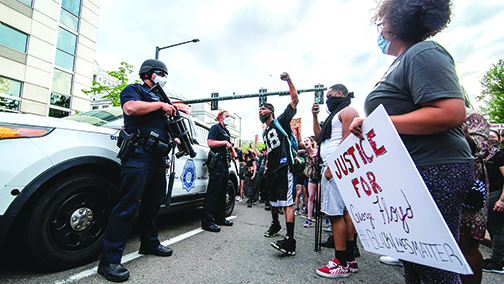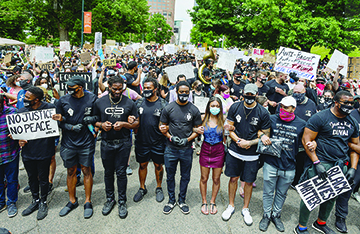By Robert Davis
Denver’s Office of the Independent Monitor (OIM) released a long-awaited report on the actions of Denver police officers during the first five days of the George Floyd Protests, saying the officers’ lack of communication, excessive force, and scant documentation are “extremely troubling.”
The report specifically addresses several gaps in the Denver Police Department’s (DPD) use of force policy, crowd control measures, and less-than lethal weapons policies which “could have played a role in command review of force while events were unfolding.”
In all, OIM made 16 recommendations, including updating DPD’s crowd control policies to track which officers are assigned the duty, issuing multiple dispersal orders before using force, and disallowing the use of rubber-ball grenades.
DPD did not respond to request for comment from the Glendale Cherry Creek Chronicle.
Monitor Nick Mitchell said the recommendations are the result of a six-month investigation that considered both the unprecedented size of the crowds and the injuries suffered by both law enforcement officer and community members.
“Welcoming this level of scrutiny is not easy, and it demonstrates a strong commitment to public safety and building community trust,” he wrote in a letter presenting the report’s findings to City Council, the Mayor’s Office, the Department of Public Safety, and the Citizen Oversight Board.
“DPD officer and command staff demonstrated a similar commitment by responding thoroughly to our extensive document requests, and volunteering to participate in interviews,” Mitchell said.
Documentation And Policy Gaps
Between June and November, OIM reviewed DPD policies as well as over 200 hours of video and audio recordings and 25 hours of video recordings from DPD’s helicopter. The OIM team then compared their findings with academic literature on law enforcement best practices.
However, several encumbrances arose during OIM’s investigation, according to Mitchell. A prime example is DPD’s after-action reports — which are supposed to be filed every time an officer uses force — were often vague and documented only a fraction of the incidents.
Department policy requires police officers to file timely Use of Force Reports that include a description of the incident and a detailed recounting of the officer’s observations and actions. However, the agency’s crowd control manual is silent on these matters, which could have led to the delayed and vague incident reports OIM reviewed. Many officers did not fill out reports until 12 days after a use of force incident occurred, the investigation found.
A “footage gap” also arose during the investigation because gaps in DPD’s body-worn camera (BWC) policy resulted in several officers failing to record footage during the protest. DPD policies state BWCs must be activated by officers during “any encounter that becomes adversarial.” This practice is meant to shield officers from false accusations of excessive force.
OIM was able to identify over 150 officers who were assigned to the protests from a roster created on June 1, the only roster received from DPD. Of this total, only 38 officers produced BWC video files.
That same day, DPD officers made 124 arrests for curfew violations, carrying a concealed weapon, burglary, and felony menacing, among other charges. Department policy notes the core purpose of the BWC policy is “to capture crimes in-progress” and that “all arrests/citations” must be recorded. DPD did not provide OIM with a reason why these 124 arrests were not recorded.
Similar comparisons for the other four days the report covers were difficult because DPD did not record the number of officers assigned to the protest. DPD estimated between 150-200 officers worked the protect on May 30, but when OIM asked to see the BWC footage, it only produced videos from 75 officers.
Lawmakers addressed this issue when they passed SB217, also known as the “Law Enforcement Integrity Act” on June 10. The bill requires officers to record all interactions with the public and the footage of which may be available to the public within 21 days of the incident. Officers may also be decertified for failing to produce BWC footage in court.
Denver City Council finalized the purchase of new BWCs that automatically begin recording when an officer draws their firearm on December 7.
Use Of Force Against Protesters
OIM also said DPD inconsistently documented its crowd dispersal orders and less-than lethal munition deployments. The Department could not assess the total number of munitions deployed during the protests even though it produced a pre-protest inventory of its less-lethal munitions. Instead, OIM found that DPD asked the Aurora and Englewood police departments for supplies before spending $202,431.50 on munitions. The Colorado State Patrol even flew a plane to Wyoming to pick up the munitions.
Some officers who deployed these munitions were not certified to do so, OIM found. DPD certifies officers to use pepper ball and 40mm rubber bullet launchers through a four-hour training course. However, OIM discovered reports from officers who claimed to receive training when they arrived to work the protests given the emergency at hand.
One potential reason for the documentation gaps, according to the report, is that DPD officers reacted to the protest emotionally rather than professionally. The report cites a 2018 study published in the Journal of Social Movement Studies that concludes “police tend to respond to demonstrations about police brutality more aggressively than to protests with other messages.”
“The challenges presented by policing mass protests are magnified exponentially when the demonstrations concern police conduct itself. Police must still balance First amendment guarantees with the need to protect life and property, but they must do so under sustained criticism from protest participants,” OIM’s 94-page document reads.
The report also mentions “sustained criticism” of DPD officers may have accelerated the use of force against George Floyd protesters. Given the caustic nature of the protest, OIM said DPD should have instituted tighter internal controls over its use of force policy and added stricter reporting requirements but failed to do so.
“When a protest is about the police, officers may be insulted, threatened, or even targeted with thrown projectiles or other improvised weapons,” the report reads. “This behavior will naturally provoke a more forceful response from the police.”
Mutual Aid
While DPD was the main respondent to the protests, 18 other law enforcement agencies provided mutual aid. They include local police departments from Arvada, Thornton, and Westminster as well as the US Federal Bureau of Investigations and the Colorado Rangers.
Mutual aid is common in police work. Departments regularly sign agreements with each other outlining the scope of the aid to be provided and the resistance thresholds to abide by. However, several of the responding departments neither negotiated nor signed mutual aid agreements with DPD prior to the protests.
Without an aid agreement in place, assisting officers were required to follow their own department’s use of force policies rather than DPD’s policy. Many of the assisting agencies had less restrictive policies than DPD, which “may have impacted the kinds of force used by officers and in what amounts,” the report reads.
This created a situation where assisting departments had varying levels of involvement. Some were tasked with crowd control while others were asked to manage traffic. Meanwhile, several agencies fired less-than lethal munitions at protesters, resulting in several complaints for excessive force against DPD. Internal investigations that determined complaints to be about assisting officers were rerouted to the appropriate agency.
During interviews, DPD officers expressed concerns about requiring mutual aid officers to follow DPD’s use of force policy because other officers are trained under different policies. OIM said the concern is understandable but can be overcome through joint periodic training and proactively negotiating mutual aid agreements.
Going Forward
OIM stopped short of sweepingly rebuking the department. However, it said DPD’s actions signaled it was caught off guard by the protests. Even so, the agency commended the leadership of Police Chief Paul Pazen and Executive Director of Safety Murphy Robinson for their commitment to reform and rebuilding community trust.
“We have full confidence in their commitment to learning from these events and making the changes necessary to prevent similar outcomes in the future,” the report concludes.
However, some community members aren’t sold on the OIM’s rosy outlook. The Citizen Oversight board, which is tasked with reviewing DPD’s disciplinary and use of force policies, said “law enforcement or the preservation of order should ever come at the expense of transparency or accountability.”
“These are military grade munitions being used against citizens expressing their First Amendment rights,” Al Gardner, COB Chair, said in a statement. “The OIM’s report raises important questions about what is appropriate use of force in response to protests and demands a closer look at what institutional accountability should look like in these circumstances.”


